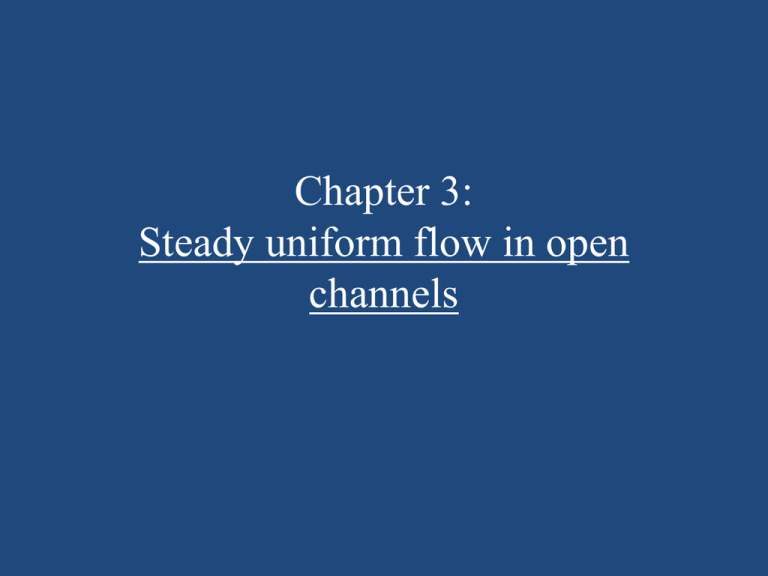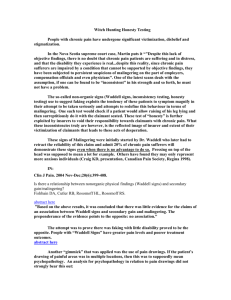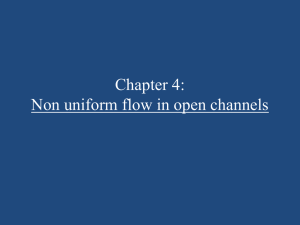Chapter 3 -Steady uniform flow in open channels
advertisement

Chapter 3: Steady uniform flow in open channels Learning outcomes • By the end of this lesson, students should be able to: – Understand the concepts and equations used in open channel flow – Determine the velocity and discharge using Chezy’s & Manning’s equation – Able to solve problems related to optimum cross section in both conduits and open channel UiTMSarawak/ FCE/ BCBidaun/ ECW301 2 Introduction • Comparison between full flow in closed conduit and flow in open channel Full flow in closed conduit Open channel flow No free surface and pressure in the Existence of free water surface through pipe is not constant out the length of flow in the channel. Pressure at the free surface remains constant, with value equal to atmospheric pressure. Flow cross sectional area remains Flow cross sectional area may change constant and it is equal to the cross throughout the length depending on the sectional area of the conduit (pipe). depth of flow. UiTMSarawak/ FCE/ BCBidaun/ ECW301 3 Flow classification based on fluid particles motion Turbulent flow Laminar Flow UiTMSarawak/ FCE/ BCBidaun/ ECW301 4 Flow classification • Turbulent flow: – Characterized by the random and irregular movement of fluid particles. – Movement of fluid particles in turbulent flow is accompanied by small fluctuations in pressure. – Flows in open channel are mainly turbulent. – E.g. Hydraulic jump from spillway, Flow in fast flowing river UiTMSarawak/ FCE/ BCBidaun/ ECW301 5 Flow classification • Laminar flow: – Flow characterized by orderly movement of fluid particles in well defined paths. – Tends to move in layers. – May be found close to the boundaries of open channel. UiTMSarawak/ FCE/ BCBidaun/ ECW301 6 For flow in pipes Turbulent Re > 2000 Laminar Re < 2000 UiTMSarawak/ FCE/ BCBidaun/ ECW301 7 Flow in open channel Turbulent Re > 500 Laminar Re < 500 UiTMSarawak/ FCE/ BCBidaun/ ECW301 8 Flow classification wrt space Uniform flow Flow parameters (velocity & pressure) remain constant wrt space at any point in the flow. E.g. Flow with a fixed discharge in a channel of constant geometrical shape and slope Non-uniform flow Flow parameters (velocity &pressure) change wrt time & space. E.g. Flow of fixed discharge through a channel which changes either in geometrical shape or slope of the channel UiTMSarawak/ FCE/ BCBidaun/ ECW301 9 Flow classification wrt time Steady flow Flow parameters remain constant over a specified time interval Unsteady flow Flow parameters vary over time UiTMSarawak/ FCE/ BCBidaun/ ECW301 10 Steady uniform flow •Flow parameters do not change wrt space (position) or time. •Velocity and cross-sectional area of the stream of fluid are the same at each cross-section. •E.g. flow of liquid through a pipe of uniform bore running completely full at constant velocity. UiTMSarawak/ FCE/ BCBidaun/ ECW301 11 Steady non-uniform flow • Flow parameters change with respect to space but remain constant with time. • Velocity and cross-sectional area of the stream may vary from cross-section to cross-section, but, for each cross-section, they will not vary with time. • E.g. flow of a liquid at a constant rate through a tapering pipe running completely full. UiTMSarawak/ FCE/ BCBidaun/ ECW301 12 Unsteady uniform flow • Flow parameters remain constant wrt space but change with time. • At a given instant of time the velocity at every point is the same, but this velocity will change with time. • E.g. accelerating flow of a liquid through a pipe of uniform bore running full, such as would occur when a pump is started. UiTMSarawak/ FCE/ BCBidaun/ ECW301 13 Unsteady non-uniform flow • Flow parameters change wrt to both time & space. • The cross-sectional area and velocity vary from point to point and also change with time. • E.g. a wave travelling along a channel. UiTMSarawak/ FCE/ BCBidaun/ ECW301 14 Flow classification • Normal depth – depth of flow under steady uniform condition. • Steady uniform condition – long channels with constant cross-sectional area & constant channel slope. – Constant Q – Constant terminal v – Therefore depth of flow is constant (yn or Dn) UiTMSarawak/ FCE/ BCBidaun/ ECW301 15 Total energy line for flow in open channel UiTMSarawak/ FCE/ BCBidaun/ ECW301 16 • From the figure : – Water depth is constant • slope of total energy line = slope of channel • When velocity and depth of flow in an open channel change, then non-uniform flow will occur. UiTMSarawak/ FCE/ BCBidaun/ ECW301 17 Flow classification • Non uniform flow in open channels can be divided into two types: – Gradually varied flow, GVF • Where changes in velocity and depth of flow take place over a long distance of the channel – Rapidly varied flow, RVF • Where changes in velocity and depth of flow occur over short distance in the channel UiTMSarawak/ FCE/ BCBidaun/ ECW301 18 Non-uniform flow UiTMSarawak/ FCE/ BCBidaun/ ECW301 19 UiTMSarawak/ FCE/ BCBidaun/ ECW301 20 UiTMSarawak/ FCE/ BCBidaun/ ECW301 21 Analysis of flow in open channel Continuity equation Momentum equation UiTMSarawak/ FCE/ BCBidaun/ ECW301 Energy equation 22 Total energy line for flow in open channel UiTMSarawak/ FCE/ BCBidaun/ ECW301 23 Continuity equation: Q1 Q2 A1v1 A2v2 • For rectangular channel: Q1 Q2 A1v1 A2 v2 B1 D1v1 B2 D2v2 • Express as flow per unit width, q: q Q vBD vD B B UiTMSarawak/ FCE/ BCBidaun/ ECW301 24 Momentum equation F Q(v2 v1 ) • Produced by the difference in hydrostatic forces at section 1 and 2: Forcein directionof motionat section1 gA1 x1 Forcein opposingdirectionof motionat section2 gA 2 x2 • Resultant force, Force Rate of changeof momentum gA1 x1 A 2 x2 Qv2 v1 Qv2 v1 A1 x1 A 2 x2 g UiTMSarawak/ FCE/ BCBidaun/ ECW301 25 Energy equation p v2 H ( z d x) g 2 g • But hydrostatic pressure at a depth x below free surface, x p g • Therefore, v2 H zd 2g • Energy equation rewritten as, 2 2 v1 v z1 d1 2 z2 d 2 hL 2g 2g UiTMSarawak/ FCE/ BCBidaun/ ECW301 26 Energy equation • For steady uniform flow, d1 d 2 v1 v2 2 1 2 v1 v d1 2 d 2 2g 2g • Therefore the head loss is, h z z L • And energy equation reduces to, 2 • Known as specific energy, E, (total energy per unit weight measured above bed level), v2 E UiTMSarawak/ FCE/ BCBidaun/ ECW301 2g D 27 Geometrical properties of open channels • Geometrical properties of open channels: – Flow cross-sectional area, A – Wetted perimeter, P – Hydraulic mean depth, m UiTMSarawak/ FCE/ BCBidaun/ ECW301 28 • A – covers the area where fluid takes place. D B A BD • P – total length of sides of the channel crosssection which is in contact with the flow. P B 2D A BD m P B 2D UiTMSarawak/ FCE/ BCBidaun/ ECW301 29 Example 3.1 Determine the hydraulic mean depth, m, for the trapezoidal channel shown below. UiTMSarawak/ FCE/ BCBidaun/ ECW301 30 Roughness coefficient Chezy, C Manning, n v C mi 1 2 3 12 v m i n UiTMSarawak/ FCE/ BCBidaun/ ECW301 31 Chezy’s coefficient, C • From chapter 1, fL v 2 hL m 2g • Rearranging to fit for open channel, the velocity: v C mi • Where Chezy roughness coefficient, C 2g f • For open channel i can be taken as equal to the gradient of the channel bed slope s. Therefore, v C ms UiTMSarawak/ FCE/ BCBidaun/ ECW301 32 Manning’s n • Introduced roughness coefficient n of the channel boundaries. 1 2 3 12 v m i n UiTMSarawak/ FCE/ BCBidaun/ ECW301 33 Example 3.2 Calculate the flow rate, Q in the channel shown in Figure 3.5, if the roughness coefficient n = 0.025 and the slope of the channel is 1:1600. UiTMSarawak/ FCE/ BCBidaun/ ECW301 34 Example 3.3 • Determine the flow velocity, v and the flow rate for the flow in open channel shown in the figure. The channel has a Manning’s roughness n = 0.013 and a bed slope of 1:2000. B 2.75 m 900 UiTMSarawak/ FCE/ BCBidaun/ ECW301 35 Example 3.4 (Douglas, 2006) • An open channel has a cross section in the form of trapezium with the bottom width B of 4 m and side slopes of 1 vertical to 11/2 horizontal. Assuming that the roughness coefficient n is 0.025, the bed slope is 1/1800 and the depth of the water is 1.2 m, find the volume rate of flow Q using a. Chezy formula (C=38.6) b. Manning formula UiTMSarawak/ FCE/ BCBidaun/ ECW301 36 Example 3.5 (Munson, 2010) • Water flows along the drainage canal having the properties shown in figure. The bottom slope so = 0.002. Estimate the flow rate when the depth is 0.42 m . UiTMSarawak/ FCE/ BCBidaun/ ECW301 37 Example 3.6 (Bansal, 2003) Find the discharge of water through the channel shown in figure. Take the value of Chezy’s constant = 60 and slope of the bed as 1 in 2000. A D 1.2 m C 2.7 m B 1.5 m E UiTMSarawak/ FCE/ BCBidaun/ ECW301 38 Example 3.8 (Bansal, 2003) Find the diameter of a circular sewer pipe which is laid at a slope of 1 in 8000 and carries a discharge of 800 L/s when flowing half full. Take the value of Manning’s n = 0.020. D d UiTMSarawak/ FCE/ BCBidaun/ ECW301 39 Optimum cross-sections for open channels • Optimum cross section – producing Qmax for a given area, bed slope and surface roughness, which would be that with Pmin and Amin therefore tend to be the cheapest. • Qmax : Amin, Pmin UiTMSarawak/ FCE/ BCBidaun/ ECW301 40 Example 3.9 Given that the flow in the channel shown in figure is a maximum, determine the dimensions of the channel. UiTMSarawak/ FCE/ BCBidaun/ ECW301 41 Optimum depth for non-full flow in closed conduits • Partially full in pipes can be treated same as flow in an open channel due to presence of a free water surface. UiTMSarawak/ FCE/ BCBidaun/ ECW301 42 Optimum depth for non-full flow in closed conduits • Flow cross sectional area, A sectorOMNP - triangleOMP 1 2 r 2 r 2 sin cos 2 1 2 r sin 2 2 • Wetted perimeter, P 2 r UiTMSarawak/ FCE/ BCBidaun/ ECW301 43 Optimum depth for non-full flow in closed conduits • Under optimum condition, vmax, P 1 P dA A dP 0 d A 2 d P d dA dP P A d d d • Substituting & simplifying, 2 tan 2 257.50 UiTMSarawak/ FCE/ BCBidaun/ ECW301 44 Optimum depth for non-full flow in closed conduits • Hence depth, D, at vmax, D 1.62r 0.81d • Using Chezy equation, 1 Q ACm i A C P 3 2 1 2 1 2 12 i UiTMSarawak/ FCE/ BCBidaun/ ECW301 45 Optimum depth for non-full flow in closed conduits • Qmax occurs when (A3/P) is maximum, P 1 3PA dA A dP 0 3 d A d P dA dP 3P A d d 2 2 3 d d • Substituting & simplifying, 2 3080 1540 • Therefore depth at Qmax, D 1 .9 r 0.95d UiTMSarawak/ FCE/ BCBidaun/ ECW301 46 Review of past semesters’ questions OCT 2010 • Analysis of flow in open channels is based on equations established in the study of fluid mechanics. State the equations. UiTMSarawak/ FCE/ BCBidaun/ ECW301 48 OCT 2010 • Determine the discharge in the channel (n = 0.013) as shown in Figure Q3(b). The channel has side slopes of 2 : 3 (vertical to horizontal) and a slope of 1 : 1000. Determine also the discharge if the depth increases by 0.1 m by using Manning's equation. UiTMSarawak/ FCE/ BCBidaun/ ECW301 49 OCT 2010 • State the differences between : i) Steady and unsteady flow ii) Uniform and non-uniform flow UiTMSarawak/ FCE/ BCBidaun/ ECW301 50 OCT 2010 • Figure Q4(b) shows the channel. Prove that for a channel, the optimum cross-section occurs when the width is 4 times its depth (B = 4D). (Hint: A = 4/3BD and P = B + 4D) UiTMSarawak/ FCE/ BCBidaun/ ECW301 51











